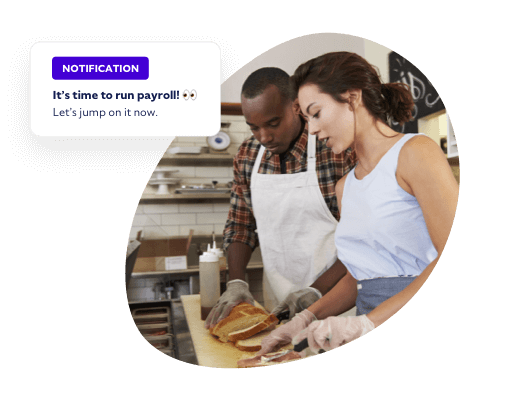Ridiculously easy
paycheck calculator
paycheck calculator
Want to crunch the numbers on your employees' wages?
No need to guesstimate on your own. Use our super simplified Salary Paycheck Calculator to perform gross-to-net and gross-up calculations to estimate take-home pay for workers in
all 50 states.

Powerful paycheck transparency
Roll's Salary Paycheck Calculator is a convenient, expert-backed tool that can help small business owners and solorprenuers simplify their HR and budgeting processes.
Get the actual pre- and post-tax value of annual salaries to make budgeting and economic planning a breeze.
Gain salary clarity
with a reliable tool
Simply fill out the fields below to the best of your knowledge and get your earnings estimate. Just give us the data and our gross income calculator will do the math for you. If you get stuck, visit our handy paycheck calculator guide to learn more.
Important note on the salary paycheck calculator: The calculator on this page is provided through the ADP Employer Resource Center and is designed to provide general guidance and estimates. It should not be relied upon to calculate exact taxes, payroll or other financial data. These calculators are not intended to provide tax or legal advice and do not represent any ADP service or solution. You should refer to a professional advisor or accountant regarding any specific requirements or concerns.
Own a small business?
Let Roll run payroll for you.
Roll's Salary Paycheck Calculator guide

Paycheck 101
While most paychecks look pretty much the same, their delivery schedules can vary from business to business. Several factors can dictate how often paychecks are disbursed, including applicable state laws and regulations, and even your own preference as an employer. Check out the Roll blog to learn how to choose the right pay schedule for your business.

W-4 federal tax form
The W-4 form is an important IRS document that employees should complete to instruct employers on how much federal income tax to withhold from their paychecks each pay period. Information such as filing status, dependents, other income, and adjustments must be provided. It's critical to keep W-4s up-to-date if personal or financial situations change, like getting married or having a child, to ensure tax withholding remains accurate throughout the year and to avoid costly surprises when Tax Season rolls around.

Pay frequency
How often an employee gets paid (aka pay frequency) impacts budgeting, cash flow, and overall financial planning. Consider employee preference, business needs, and legal requirements when deciding pay scheduling. Keep in mind that some states mandate minimum pay frequencies for specific employee types.
- Weekly paychecks (one per week) offer the most frequent financial influx, making it ideal for budgeting and managing short-term expenses.
- Bi-weekly paychecks (one every two weeks) balance frequency with more significant individual amounts. It aligns well with standard billing cycles and simplifies bookkeeping for some businesses.
- A semimonthly pay frequency means employees receive pay twice a month, usually on fixed dates, and means a predictable income stream for consistent budgeting.
- Monthly paychecks arrive once a month, offering the largest individual amount but the least frequent income flow. This frequency might suit salaried employees with predictable expenses.

Paycheck essentials
Regardless of their frequency, all paychecks should contain the same basic information:
- Check number
- Employer’s name and address
- Employee’s name and address
- Check date
- Payment amount
- Employee’s bank account and routing numbers (for direct deposits)
- Check memo (optional)

Pay stub basics
Most states require employers to provide each employee with a pay stub as well. These typically come with paychecks and list details such as:
- Name and address
- Pay period
- Hours worked
- Gross pay
- Deductions (i.e. taxes, wage garnishments)
- Social Security and Medicare
- Benefits
- Net pay
- Year-to-date earnings

Pay empowerment for employees
Wondering what you'll earn each payday? Roll's Salary Paycheck Calculator can provide financial clarity and pay transparency for employees, too!
- Unravel paycheck deductions, taxes, and withholdings to get a clear picture of what actual earnings you will receive.
- Confidently budget for expenses, savings, and debt repayment to take control of your financial future.
- Evaluate job offers by comparing take-home pay across different opportunities, consider benefits and deductions, and choose the best career path for your personal needs.
Payroll terms explained
- Benefit deductions
- If your business offers health insurance, dental insurance, 401k retirement savings plans and other benefits, you’ll often share those costs with your employees and withhold it from their pay in the form of payroll deductions. Depending on the type of benefit and the regulations that apply to it, the deduction may be pre-tax or post-tax. Pre-tax is more advantageous to workers because it lowers the individual’s taxable income. One additional advantage to offering employees benefits is that businesses then become eligible for certain tax credits, reducing the overall amount of taxes owed.
- Wage garnishments
- Outside factors, such as wage garnishments, can also play a part in take-home pay. For instance, you may need to deduct garnishments from employee wages if they receive a court order to do so. This can occur for a variety of reasons, such as the employee is required to pay child support or alimony. Rather than deducting a fixed dollar amount, garnished wages are generally a percentage of an employee's earnings.
- Federal income tax withholding
- Employers withhold federal income tax from workers’ pay based on current tax rates, Form W-4, and Employee Withholding Certificates. When finishing this form, workers should add their filing status and note if they are claiming any dependents, are employed at multiple places or have a spouse who also works (for married filing jointly purposes), or need any other necessary adjustments.
- FICA withholding
- FICA (Federal Insurance Contributions Act) is a two-part tax. Both employees and employers pay 1.45% for Medicare and 6.2% for Social Security. The latter has a wage base limit of $147,000, which means that after employees earn that much, the tax is no longer deducted from their earnings for the rest of the year. Those with high income may also be subject to Additional Medicare tax, which is 0.9%, paid for only by the employee, not the employer.
- State and local tax withholding
- State and local taxes vary depending on where you or your employees live. Make sure to keep in mind:
State and local income tax
State unemployment tax (SUTA)
Short-term disability
Paid family medical leave
Use Roll's annual income calculator to calculate an employee's yearly income after federal, state, and local taxes are deducted. You can also use the net pay calculator to get an accurate hourly, weekly or monthly pay estimate. You can also use ADP’s quick search tool to determine your state and local tax amounts.
- Exempt vs. Non-Exempt Employees
It's important to know the difference between exempt and non-exempt employees, as it determines overtime eligibility. Exempt employees, who are typically salaried professionals, are not entitled to overtime pay. On the other hand, non-exempt employees, who are often hourly workers, are entitled to overtime pay after exceeding a certain number of hours per week. Employers need to understand this distinction to avoid payroll errors, while employees should be aware of their classification to ensure they are receiving proper compensation.
- Accrued Vacation/Sick Leave
Accrued vacation/sick leave refers to earned but unused vacation or sick leave days that accumulate over time. This can be a bit confusing for both employees and employers, especially when considering carryover policies and potential payout upon termination. It's important for employees to keep track of their accrued leave days, and for employers to manage them properly. Understanding the company's policies regarding accrued leave will help ensure that employees receive the time off they're entitled to and that employers avoid any confusion or disputes.
Frequently asked questions
- How do you calculate annual income?
- A simple method is to multiply the total income (before tax deductions) by the number of pay periods in a year to find the annual salary. For example, if a worker earns $2,500 bi-weekly, their pre-tax annual income would be 1,500 x 26 = $39,000. However, this doesn’t include taxes, deductions and other variables. Roll’s income calculator takes this headache out of the equation, accounting for the various factors that can affect someone’s pay.
- Is a pay stub the same as a paycheck?
- What should a pay stub look like?
- Pay stubs typically contain information like hours worked during a particular period, net income, taxes withheld, the employee’s voluntary deductions, other benefits received, and more. [See above for a full list.] Additional information may be present on the stub depending on state or local requirements.
- What should your employees do with their paycheck stubs?
- Pay stubs are most often used to verify payment accuracy, so they might be needed to settle wage or hour disputes. It’s always a good idea for employees to hang on to their pay stubs, though they are by no means required to do so.
- What should you do if your employees don't receive their paycheck or their paycheck is late?
First, check with your HR department (if you have one) to see if the cause was a simple honest mistake. From there, depending on the reason for the missed or late paycheck, you can chart out your next course of action.
If you notice that your paychecks are regularly arriving late or having issues with delivery, follow this process:
- Order check stock from an office supply store or the bank that has the business payroll account and print the checks yourself each pay period.
- Work with a payroll provider to automate tasks for you.
- Can my employees access their pay stubs online?
With Roll by ADP, employees can log in to their own version of the app to view and print pay stubs anytime.
- Why did the paycheck amount change for an employee?
If employees noticed a change in their paycheck amount, there could be a few reasons for this. It could be due to changes in tax withholdings, an increase in benefits contributions, or an adjustment in the number of hours worked. Employees can always check with their HR department, business owner, or payroll provider to find out the exact reason for the change.
- What is the difference between gross pay and net pay?
This is a common question, and it's important to know the difference between gross pay and net pay. Gross pay is the full amount of money earned before any taxes or deductions are taken out. Net pay, on the other hand, is the amount of money taken home after all taxes and deductions have been accounted for.
- What states deduct state income tax from paychecks?
Almost all states in the United States use income tax to generate revenue for the state government. The primary reason for implementing income tax is to fund public services and infrastructure, such as education, healthcare, transportation, and public safety. Some states also use income tax to balance their budgets and maintain fiscal discipline. However, the income tax rate varies from state to state, and some states do not have an income tax. States like Alaska, Florida, Nevada, South Dakota, Texas, Washington, and Wyoming do not have a state income tax, while others like California, New York, and Oregon have relatively high-income tax rates. More information about state income tax and other tax policies on can be found on this website.
Payroll that's easier than using a calculator



Ready To Roll?
No training. No long-term contracts. Just no-hassle
payroll from your mobile device.


Related Resources
Have questions about Roll?

Success!
Thanks for reaching out.
Someone from Team Roll will reach out shortly.
You will receive a confirmation email momentarily.



